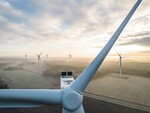News Release from SKF GmbH
Wind Industry Profile of
Statistical approach improves wind farm remote condition monitoring
The cost of operating and maintaining onshore wind farms in Europe is significant. According to the European Wind Energy Association, Operating and Maintenance (O&M) costs account for around 20 percent of the levelized cost of energy (LCOE) for onshore wind farms. As such, any measures that can be taken to reduce this cost directly translate into improved returns for investors.
This is not to say that asset owners can scrimp on O&M expenses. Inadequate O&M can lead to minor faults or defects not being recognised. This not only impacts yield but can also result in major component failure, potentially leading to costly repairs and lengthy downtime.
O&M is a growing issue for the wind industry. Due to the increased probability of component failure and that defects will fall outside of the manufacturer’s warranty period, the importance and cost of O&M increases with the length of time from commissioning. Given that approximately 75 percent of all onshore wind turbines installed in Europe have been operating for less than ten years, this is an issue of growing relevance.
As a leading supplier to the wind energy sector, SKF manufactures numerous components including different bearings for the drive train, along with lubrication and sealing solutions. But our expertise does not end there. Ten years ago SKF developed a vibration monitoring system and opened a remote monitoring centre. Condition monitoring is the process of determining the condition of machinery while in operation. The key to a successful condition monitoring programme includes knowing what to listen for, how to interpret it and when to put this knowledge to use. Condition monitoring Systems (CMS) not only help wind farm operators reduce the possibility of catastrophic failure, but also allow them to order parts in advance, schedule manpower and machines, and plan other repairs during the downtime.
With our hosted software and monitoring services, implementing a world-class predictive maintenance programme for periodic and mainly continuous monitoring of wind turbines is just an Internet connection away. SKF Remote Monitoring Services use SKF condition monitoring tools such as the SKF IMx on-line system, dedicated to wind turbines, to collect data. Based on the results experts analyse data, and use the Internet to communicate management of machine health for informed decision-making.
However, times are changing for CMS, heralded by technology and communication enhancement. To achieve improved operations, the maintenance strategy of operators needs to be shifted from a scheduled model to a predictive model.
Several years ago with the number of wind assets to monitor increasing along with the amount of data collected growing, SKF had to find a way to improve the efficiency of the process. We had to invent new ways of treating the data and that is when we started utilising statistical techniques.
But the volume of data collected from a large wind farm is staggering. As a rule of thumb there are approximately eight sensors on a geared wind turbine with roughly three measurements for each of them, 24 indicators in total; one indicator is one spectrum and one overall value. This information is collected by the condition monitoring hardware and is sent over the Internet, either wired or wireless, to a CMS server, which can be located anywhere on the planet.
In one year with on average one download a day we have close to 9,000 spectra to analyse. If you imagine at the scale of a wind park, which could contain hundreds of turbines, it is completely impossible to analyse without using statistical modelling.
That volume of data means that we now have to use statistical data. This is used to compare the turbines between each other as much as that is possible given differences in location and models. First we compare what is comparable and then we use the historical data we have amassed over the ten years of monitoring windfarms of different models. Based on this history of the data, dependent on turbine type, we use this as background for the new machine that we start to monitor.
Even before we turned to statistical tools, the application of CMS to wind farms was unique, due to the limitations in applying traditional techniques from other industries. The wind turbine is a complicated machine, with a great many variables. Unlike other industries we cannot apply one model of alarm level to all machines; unfortunately, it does not work like that. So we have to develop individual alarm models that allow us to rapidly compare the machines, which can be compared. But to attempt to do this without being guided by the statistics, filter and selection would be impossible in a reasonable amount of time.
A further benefit comes from the growing pool of historical data. This historic data is extremely useful, especially if it contains the entire lifecycle of the unit from installation. Unfortunately, this is not always the case. Even though an increasing number of turbines are factory fitted with monitoring technology, much of the existing fleet requires retrofitting; this traditionally occurs close to the end of the warranty period or when the operator or the service provider wants to renew the service contract.
It is, however, vital to select the right kinematic data to analyse to help increase the process accuracy. The system has some features that allows it to scan for potential theoretical defaults. To do this automatic scanning you need to rely on the actual information on the type of components in the system. Each gearing has its own theoretical frequency, so without having a certain level of certainty of the kinematics inside the turbine, you will need to rely on assumptions that will require more input by the analyst.
But today, given our extensive historical database, we have a good understanding and good background on the components inside the gearbox and inside the generator. Based on our experience not all the components in wind turbines need the same level of expertise to be analysed. Detecting a generator bearing issue is quite easy, but with planetary bearings and gears it is much more problematic. We have developed specific algorithms that are really focussed on the detection of the planetary gearings themselves with a specific algorithm.
The final goal is to quickly identify which turbine among the fleet needs to be analysed further. The statistical approach is a complement to the traditional diagnostic to highlight it quickly, to identify the turbines that potentially have an issue. And on those ones, the specialists need to spend some time looking at the vibration signals to determine the issues.
The aim now is to broaden the fleet analysis perspective within the global background that we have built up from among the more than 2000 turbines analysed within SKF. To achieve this a statistical model will be built of vibration comparison for each turbine model and their components over various locations and loading conditions.
This is done by improving the process, by adding regular workshops between the specialists, sharing the issues and sharing the ideas of improvement; creating a global network within the wind CMS community.
So what does this deliver to the operators? It will allow us to tailor the alarms so they only receive information about an issue that is likely to have a detrimental impact on performance, without bothering the operator with false alarms or needless levels of information.
As for the future, the accuracy and scope of CMS will continue to evolve and we continue to push the boundaries of the technology. One of the next steps will be to integrate all the relevant sources of information such as temperature, process parameters and add these to the diagnostics that vibration allows.
The other trends are to be able to hook that CMS data to another more holistic system again to allow better correlation. This is a major driver from the turbine manufacturers, but as always it comes down to cost. Given the high volume of wind turbines there is a lot of pressure to decrease the cost. Our goal is to make the technology more affordable.
After ten years using vibration monitoring we can improve the availability of the wind assets by one percent while at the same time reducing operating and maintenance costs by two percent. By utilising SKF’s statistical-based CMS, operators can save as much as €5,000 per year per wind turbine. But one fact is certain, as margins for wind farm operators continue to be squeezed every last bit of efficiency is vital to maintain profitability; and a vital tool to help achieve that is the improved prediction capabilities of statistical CMS.
- Source:
- SKF
- Link:
- www.skf.com/...
- Keywords:
- SKF, O&M, CMS, condition monitoring, wind farms, efficiency























